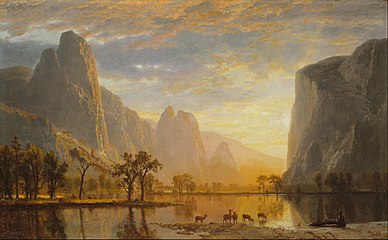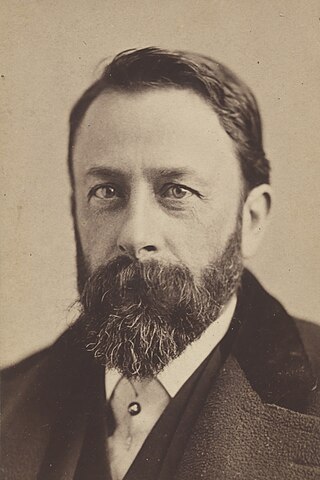
Albert Bierstadt was a German American painter best known for his lavish, sweeping landscapes of the American West. He joined several journeys of the Westward Expansion to paint the scenes. He was not the first artist to record the sites, but he was the foremost painter of them for the remainder of the 19th century.

The Hudson River School was a mid-19th-century American art movement embodied by a group of landscape painters whose aesthetic vision was influenced by Romanticism. Early on, the paintings typically depicted the Hudson River Valley and the surrounding area, including the Catskill, Adirondack, and White Mountains.
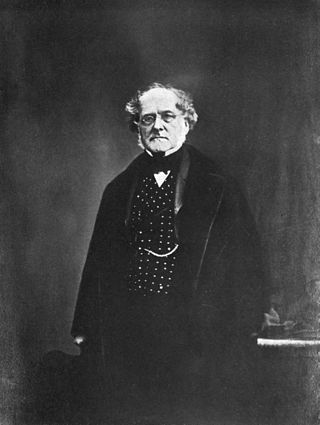
James Lenox was an American bibliophile and philanthropist. His collection of paintings and books eventually became known as the Lenox Library and in 1895 became part of the New York Public Library.

Thomas Worthington Whittredge was an American artist of the Hudson River School. Whittredge was a highly regarded artist of his time, and was friends with several leading Hudson River School artists including Albert Bierstadt and Sanford Robinson Gifford. He traveled widely and excelled at landscape painting, many examples of which are now in major museums. He served as president of the National Academy of Design from 1874 to 1875 and was a member of the selection committees for the 1876 Philadelphia Centennial Exposition and the 1878 Paris Exposition, both important venues for artists of the day.

Enoch Wood Perry Jr. was a painter from the United States.

The St. Johnsbury Athenaeum is a combined library and art gallery, in St. Johnsbury, Vermont. The building in which it is housed is architecturally and historically significant because of its construction. The Athenaeum is also noted for the American landscape paintings and books in its collection and its having been funded by Horace Fairbanks, manufacturer of the world's first platform scale. The art collection contains a number of Hudson River School paintings. This building retains a strong Victorian flavor of the 19th century.

Alfred Thompson Bricher was an American painter associated with White Mountain art and the Hudson River School.

William Keith was a Scottish-American painter famous for his California landscapes. He is associated with Tonalism and the American Barbizon school. Although most of his career was spent in California, he started out in New York, made two extended study trips to Europe, and had a studio in Boston in 1871–72 and one in New York in 1880.
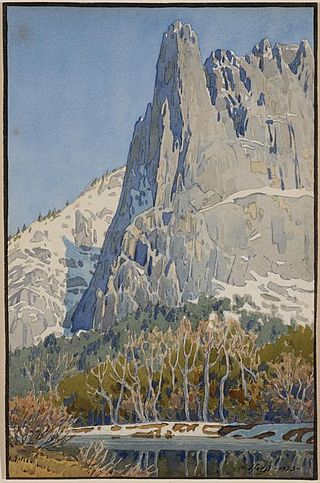
Gunnar Mauritz Widforss was a Swedish American artist who specialized in painting subjects from the wilderness in watercolor. Widforss is most frequently associated with landscapes from American National Parks.

Early California Artists are a subset of American Western artists, painting in the mid-to-late 19th century. Their styles varied from realistic representation to the imagined.

The Rocky Mountains, Lander's Peak is an 1863 landscape oil painting by the German-American painter Albert Bierstadt. It is based on sketches made during Bierstadt's travels with Frederick W. Lander's Honey Road Survey Party in 1859. The painting shows Lander's Peak in the Wyoming Range of the Rocky Mountains, with an encampment of Native Americans in the foreground. It has been compared to, and exhibited with, The Heart of the Andes by Frederic Edwin Church. Lander's Peak immediately became a critical and popular success and sold in 1865 for $25,000.
Charles Dorman Robinson was an American panorama, cyclorama, landscape, and marine painter. He is known for his seascapes and landscapes of Northern California, including over a hundred paintings of Yosemite Valley. He was known as "the dean of Pacific Coast artists".
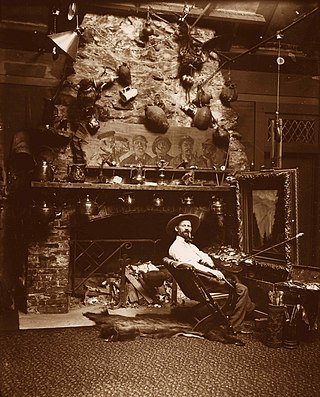
Christian August Jorgensen was a Norwegian-born American landscape painter. Jorgensen is best known for his paintings of Yosemite Valley and the California Missions.

The Lenox Library was a library incorporated and endowed in 1870. It was both an architectural and intellectual landmark in Gilded Age–era New York City. It was founded by bibliophile and philanthropist James Lenox, and located on Fifth Avenue between 70th and 71st Streets on the Upper East Side of Manhattan. Renowned architect Richard Morris Hunt designed the building, which was considered one of the city's most notable buildings, until its destruction in 1912.
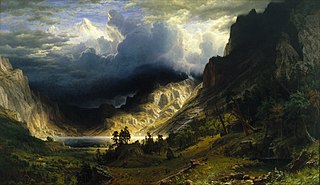
A Storm in the Rocky Mountains, Mt. Rosalie is an 1866 landscape oil painting by German-American painter Albert Bierstadt (1830-1902) which was inspired by sketches created on an 1863 expedition.

Expulsion from the Garden of Eden was painted in 1828 by English-born American painter Thomas Cole. It belongs to the collection of the Museum of Fine Arts, Boston and is on display in their Waleska Evans James Gallery. This landscape painting exemplifies the style of the Hudson River School, which was a group of American landscape painters that Thomas Cole is credited with founding. On the lower left part of the cliff, Cole signed his name as "T Cole".

Dismissal of School on an October Afternoon was painted by Henry Inman. An elected founding member of the National Academy of Design, Inman was well known in the New York City art scene. Although predominately known for his portrait paintings, Henry Inman was also known for painting genre scenes and literary subjects. Commissioned by James Cozzens, this painting was finished on November 8, 1845, which makes it his last completed painting before his January 1846 death. It is a culmination of his successful career, as it is a blend of landscape, genre, and literary reference.
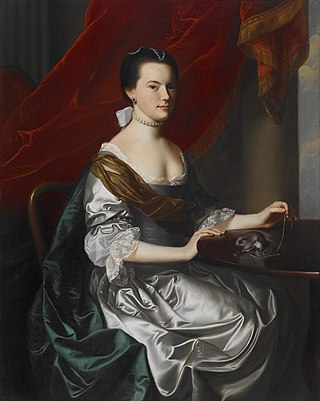
Mrs. Theodore Atkinson Jr. is an oil-on-canvas portrait painting completed in 1765 by the American artist John Singleton Copley. It is now housed in the Crystal Bridges Museum of American Art.

The Falls of St. Anthony is an 1880 oil landscape painting by the Hudson River School artist Albert Bierstadt.
